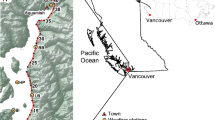Conclusions
Rock bursts in underground coal pits are not only affected by geological and mining-technological factors, but also depend on the following astronomical factors.
The probability of rock bursts increases with the tidal influence of the moon on the earth. The probability of rock bursts is highest when the moon is at perigee, and lowest when it is at apogee.
The probability of rock bursts falls as solar activity increases. The probability of bursts is highest in years of minimum solar activity and lowest in years of maximum solar activity.
Similar content being viewed by others
Literature Cited
A. A. Skochinskii, “Modern ideas on the nature of rock bursts in pits, and measures to combat them,” Ugol', No. 7 (1954).
V. V. Khodot, Rock Bursts [in Russian], Gosgortekhizdat, Moscow (1961).
B. L. Lichkov, “On the value of a theory of the earth and the need to create one,” Geographical Symposium, Vol. XV, Astrogeology [in Russian], Izd. AN SSSR, Moscow-Leningrad (1962).
B. L. Lichkov, The Natural Waters of the Earth and the Lithosphere [in Russian], Izd. AN SSSR, Moscow-Leningrad (1960).
H. Nagaoka, Fluctuations in the Secular Variation of the Rotation of the Earth and Volcanic Eruptions, Proceedings Imper. Acad. of Japan,9, No. 12 (1933).
G. P. Tamrazyan, Earthquakes in the Kazbek Region and Elastic Tides [in Russian], Izd. Akad. Nauk SSSR, No. 7 (1956).
M. S. Éigenson, M. N. Gnevyshev, A. I. Ol', and B. M. Rubashev, Solar Activity and Its Terrestrial Manifestations [in Russian], OGIZ, Moscow-Leningrad (1943).
C. Lyell, Fundamental Principles of Geology, or the Most Recent Changes in the Earth and Its Inhabitants [Russian translation], Vol. II, Moscow (1866).
A. J. Henri, Month. Weather Rev.,49, 281 (1921).
N. V. Kolobkov, “Solar activity, weather, climate,” Priroda, No. 8 (1960).
A. A. Skochinskii and V. B. Komarov, Mine Ventilation [in Russian], Moscow-Leningrad (1951).
M. N. Averbakh, “The influence of depression on gas emission,” Ugol', No. 7 (1958).
V. V. Khodot, “Theory and practice of measures against rock bursts in coal pits,” in: The Campaign against Rock Bursts [in Russian], Gosgortekhizdat, Moscow (1962).
I. V. Bobrov, R. M. Krichevskii, and V. I. Mikhailov, Rock Bursts in Coal Pits in the Donbass [in Russian], Ugletekhizdat, Moscow (1954).
Author information
Authors and Affiliations
Additional information
Translated from Fiziko-Tekhnicheskie Problemy Razrabotki Poleznykh Iskopaemykh, No. 4, pp. 33–37, July–August, 1969.
Rights and permissions
About this article
Cite this article
Puzyrev, V.N. Relations between rock bursts in pits and periodically varying astronomical factors. Soviet Mining Science 5, 395–398 (1969). https://doi.org/10.1007/BF02501402
Received:
Published:
Issue Date:
DOI: https://doi.org/10.1007/BF02501402




